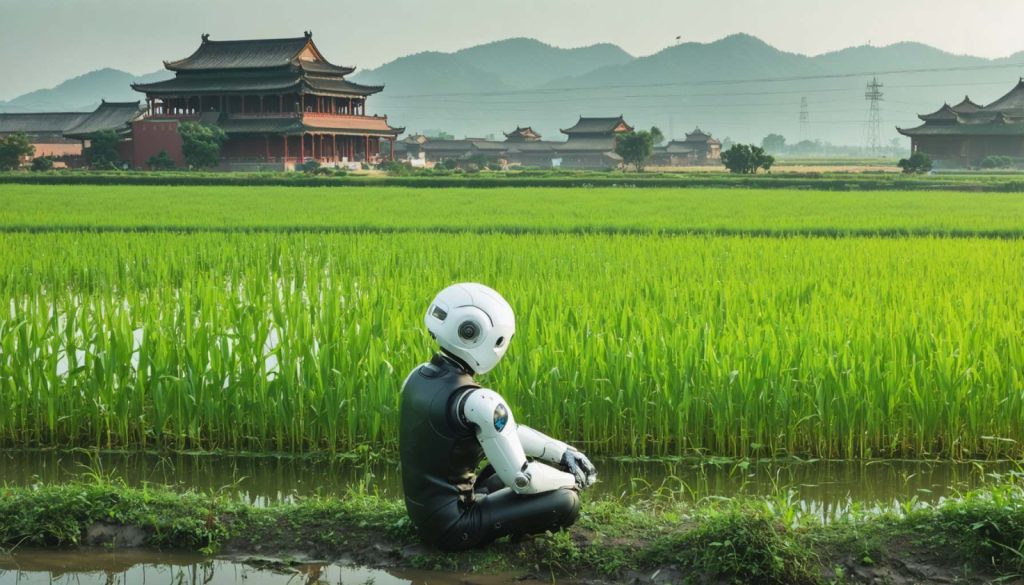
- AI technology is transforming agriculture in China’s rural areas such as Jilin, Yunnan, and Hubei.
- Farmers are using AI tools like drones and sensors to improve efficiency and crop yields.
- Predictive models help manage weather impacts, soil health, and plant diseases effectively.
- Sensor systems provide real-time data for proactive management of flood-prone areas.
- AI adoption in farming challenges the notion that tech progress is limited to urban centers.
- This revolution highlights the democratization of innovation, blending traditional practices with modern tech.
- The transformation in the countryside points to a future where technological breakthroughs can originate from unexpected places.
An unexpected revolution is unfurling across the serene rice paddies of China’s countryside, far from the noisy demands of high-stakes tech capitals. In regions like Jilin, Yunnan, and Hubei, rice farmers are embracing cutting-edge artificial intelligence, creating a transformation that is rewriting the playbook of agricultural innovation.
Imagine sprawling fields, lush with grains of rice, and the hushed sounds of rural landscapes replaced by the rhythmic hum of drone rotors and the soft alert of sensors pinging from strategic points across the land. This is the new symphony of China’s agricultural heartland.
Farmers, traditionally seen as the stoic keepers of timeless practices, are now, unlikely tech trailblazers, wielding AI to thrust agriculture into the modern era. Their fields, once vulnerable to floods and disease, are now fortified by predictive models. These AI systems analyze weather patterns, soil health, and crop vitality with precision and speed beyond human capability.
Flood-prone regions are interlaced with sensors that monitor real-time data, sending automatic alerts that allow farmers to preemptively adjust their drainage systems. Meanwhile, drones equipped with AI-powered imaging technology survey vast tracts of farmland, identifying early signs of plant diseases and notifying farmers before the naked eye can discern the looming threats.
This surge in tech adoption paints a vivid portrait of efficiency, vastly reducing waste and ensuring better yields. The core of this transformation lies not in creating the most powerful AI models but in seamlessly integrating intelligent technology into everyday practices.
As this quiet revolution ripples through China’s countryside, it defies the conventional narrative that economic prosperity and technological advancements are solely the province of high-density urban areas or colossal tech giants. Instead, it symbolizes a paradigm shift, proving that the true potential of AI lies in its ability to democratize innovation, bridging the gap between the avant-garde and the traditional.
The innovation unfolding in these rural areas challenges global perceptions, suggesting that tomorrow’s breakthroughs may not come from towering skyscrapers or bustling cities, but rather from the fields that sustain us, nurtured by those willing to sow seeds of change. This revolution reminds us that the future of technology is not just about building more; it is about building better, and above all, it is about building together.
How AI is Transforming China’s Rice Fields: A Peek into the Future of Farming
AI in Agriculture: Beyond the Basics
The quiet but profound technological transformation in China’s rice fields is not just limited to drone and sensor usage. Here are some deeper insights and implications that were not fully explored in the source article:
Real-World Use Cases
1. Precision Farming: AI and machine learning models provide detailed analyses of soil moisture and nutrient levels, enabling farmers to apply fertilizers and irrigation precisely when and where needed, optimizing resource use and enhancing yields.
2. Disease Surveillance: Besides disease detection, AI systems can predict disease outbreaks based on historical data and environmental conditions, allowing for timely interventions.
3. Robotics in Harvesting: Sophisticated AI-integrated robots are being developed to aid in harvesting, significantly reducing labor costs and improving efficiency.
Industry Trends and Market Forecasts
– Global Industry Growth: The agricultural AI market is expected to grow exponentially, reaching nearly $4 billion by 2026, as per a report by Markets and Markets. This growth is driven by increasing demand for food production and efficiency improvements.
– Investment in Agri-Tech: Many countries, not just China, are investing heavily in AI for agriculture, fostering an environment ripe for innovation and technological breakthroughs on farms worldwide.
Features, Specs & Pricing
– Drones: Modern agricultural drones equipped with AI are becoming more affordable, with starting prices around $1,500, making them accessible to a broader range of farmers.
– Sensors: Soil and water sensors cost between $50 to $200, depending on their capabilities, offering real-time data analytics for proactive farm management.
Security & Sustainability
– Data Security: As AI in agriculture incorporates more data, ensuring the integrity and security of this information against cyber threats becomes essential.
– Environmental Sustainability: AI-driven agriculture promotes sustainability by reducing chemical usage and minimizing water waste, ultimately contributing to eco-friendly farming practices.
Pros & Cons Overview
Pros:
– Increased crop yields and quality.
– Reduced labor and operational costs.
– Proactive management of environmental risks.
Cons:
– High initial investment and technology adoption costs.
– Potential data privacy concerns.
– Need for farmer training and adaptation to new technologies.
Actionable Recommendations
– Adopt Gradual Integration: Farmers should start with basic AI tools such as soil sensors before advancing to more complex systems like AI-powered drones.
– Continuous Education: Engage in workshops and training sessions on new technologies to keep pace with the evolving agricultural tech landscape.
– Collaborative Approach: Work with local tech firms and agricultural experts to ensure a sustainable transition to AI-enabled farming.
Insights & Predictions
As AI technology continues to proliferate across the agricultural sector, it is likely to lead to a second Green Revolution, one that harnesses data and intelligent computing to sustain the growing global population.
For more information on AI technologies in various sectors, visit IBM.
Explore how AI and machine learning are making waves across industries worldwide by visiting NVIDIA.



